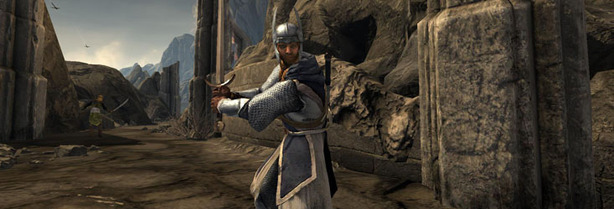
Lord of the Rings: Conquest
Platform: PC, Xbox 360, PlayStation 3Publisher: Electronic Arts
UK Price (as reviewed): £26.99 (inc. VAT)
US Price (as reviewed): $49.99 (ex. Tax)
Between our midnight matches of HL2 DM and our groggy and often woefully decaffeinated starts to the working day, it’s usually us that are a bit late to start work at the moment, but with Lord of The Rings: Conquest we can’t help but feel that Electronic Arts is even later than us.
A lacklustre third person hack and slash based on the Lords of the Rings franchise? The boat for that sailed about three years ago, thanks.
Regardless, there is some merit to Pandemic’s attempt at an epic, class-based and multiplayer focused brawler at least. The game does at least feel like a run down of the highlights from Peter Jackson’s acclaimed trilogy of movies, even if the scale has been dramatically pulled back in some places.
The basic structure to the game then is pretty much spelled out by a list of its key features. Players take over the role of soldiers in one of the armies in the Lord of the Rings universe and are thrown in to all the most massive battles. From the defence of Helms Deep to the assault on The Black Gate, all the important bits are here.
It’s basically, as Harry so succinctly put it in one of his hourly (and hour long) looking-over-my-shoulder sessions, Mercenaries 2: Fuel of Mordor.
Comparing LOTR: Conquest to Pandemic’s other recent third person shooter though is a bit misleading it has to be said. Mercenaries had levels that were bigger than a Haribo that’s been soaked in water for two weeks, gained self-awareness, hit puberty and decided that it wants to make a profession out of writing long and rambling similes that don’t really mean anything.
Conquest by comparison has some very small and very linear levels, with objectives that aren’t about finding smart ways to outwit the AI but rather just hammering the right mouse button until all that’s left of your enemies is a paste that looks like dried ketchup.
Mercenaries gave players a choice of three characters too, though they were all roughly identical. Conquest has four distinct, though totally archetypal, classes for players to experiment with. Players are given a certain amount of lives, or reinforcements, to accomplish their objectives with and can switch their classes whenever they spawn.
The classes themselves with be familiar to anyone who’s ever played a class-based game like this before – and there’s more of those than there are crumpled sweet wrappers littering the bit-tech offices. There’s the Archer, Warrior, Mage and Rogue. In both single and multiplayer games you can play as either the evil forces of Sauron or the allied elven, human and dwarven forces – but the classes are consistent across both factions.
Each class has a basic attack as well as a set of unique abilities that are firmly at odds with aspects of the fictional universe. Magic in Tolkien’s Lord of the Rings was usually a subtle force wielded openly only by a fearsome few, while magical weapons were both few and underpowered. Even the main character's weapons were underwhelming – a sword that glows whenever Orcs were nearby was as far as it went for Frodo, yet the playable warriors in the game have swords that can burst aflame every few minutes.
Nor is that the limit of it either. The standard archer can shoot fire and poison arrows, the mage can throw lightning and restore his comrades and the rogue can turn invisible without the aid of the One Ring. It leaves the continuity of fiction feeling a little abused to say the least.

MSI MPG Velox 100R Chassis Review
October 14 2021 | 15:04











Want to comment? Please log in.